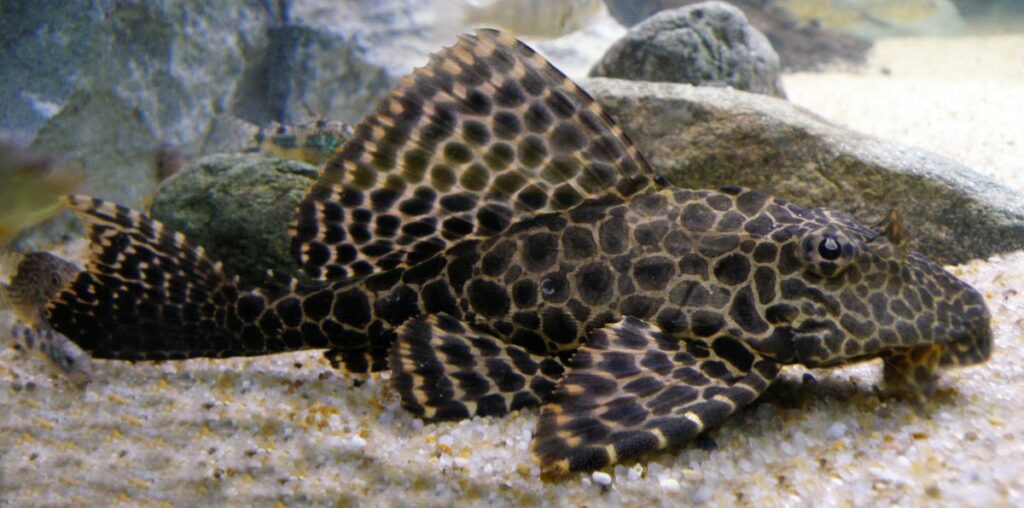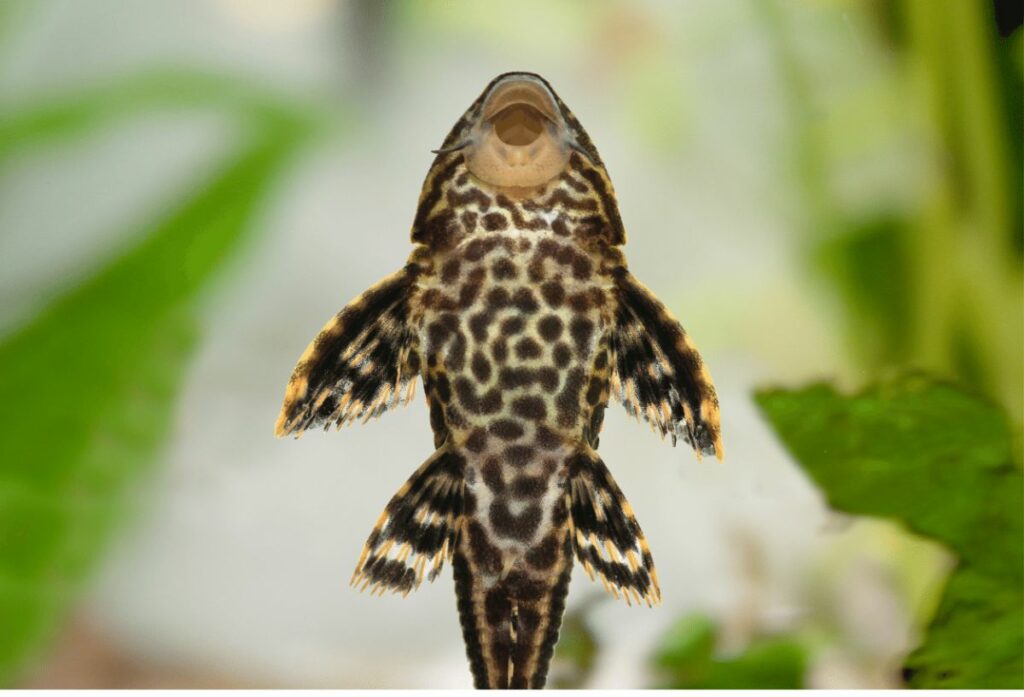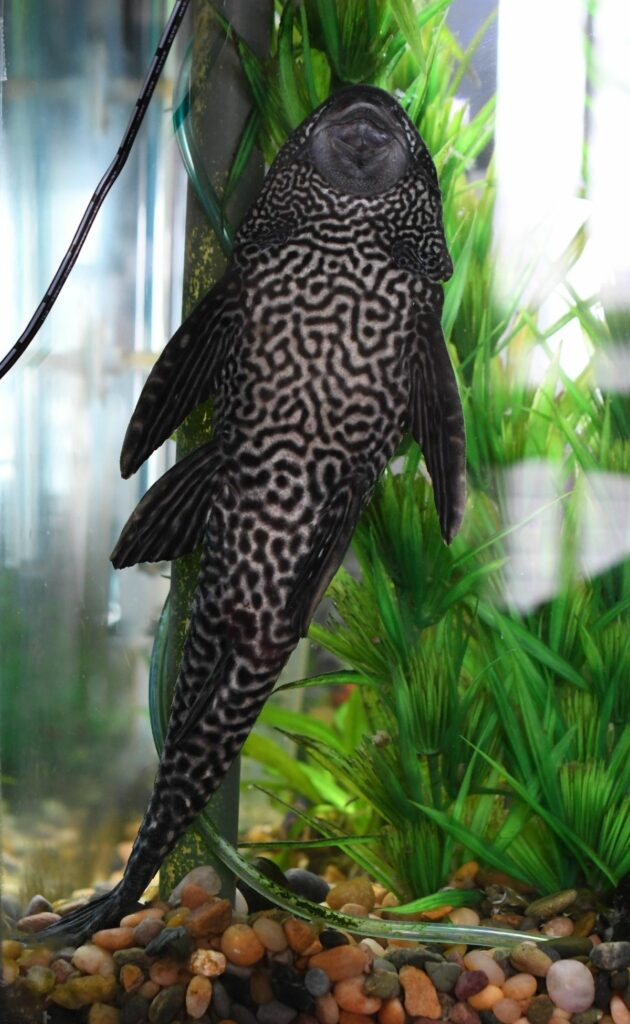The suckermouth catfish is what most people think of when they describe an “algae eater”. But, there are over 680 types of sucker fish around the world. Only a few of these kinds are available in the aquarium trade.

I’m going to focus on the Hypostomus plecostomus. This is one of the most common suckermouth catfish in the aquarium industry.
Suckermouths make good additions to freshwater tanks, but they’re not easy to take care of. Most people get them hoping they’ll clean the algae, but often, they create more of a mess than they clean up.
What Is The Suckermouth Catfish?
When most people say they’re looking for an ‘algae eater’, they’re looking for a plecostomus, or ‘pleco’.
They Have Specialized Mouthparts
These fish hang onto the sides of glass tanks and decorations with their mouths. Their mouth forms a sort of suction on the object, attaching the fish in place. This is where they get the name “suckermouth”.
These specialized mouthparts are raspy. They’re designed to grind up plant material like algae.
CABI describes them as having “bodies that are depressed and covered in flexible bony plates. They have a ventral mouth with modified lips (known as a ‘suckermouth’) with papillae (small projections) on the lips, and in some taxa, barbels. The modified mouth allows the fish to feed, breathe, and attach to the substrate through suction.”
They Have Bony Plates, Not Scales
Rather than scales, they have hard, bony plates covering their bodies. These rigid scales make the fish appear spiky, and they offer extra protection.
Plecos have large fins that span out to the sides of their bodies. They have a large, rigid dorsal fin made of spines that offer protection. These spines are also found on the tail, pectoral, and pelvic fins.
Their eyes sit at the top of their head and are tiny compared to the rest of their body.
Coloration
Suckermouth catfish are dark brown, almost black. Many have dark, or light spots and stripes down their bodies. These markings create a net-like pattern.
They Become Massive
The Hypostomus plecostomus is most often sold as a baby when it’s only about 3 in (7.6 cm) long. Many people don’t realize that they can grow up to 2 ft (0.6 m) in length. Still, the average full-size length is about 15 in (38.1 cm).
They Live A Long Time
In the right conditions, a common pleco’s average lifespan is between 10-15 years. So, not only do they grow large, but they are a longtime commitment, too.
- Common Names: Suckermouth catfish, pleco, algae eater, common pleco
- Scientific Name: Hypostomus plecostomus
- Origin: South America — Brazil, Trinidad, Tobago, & the Guianas
- Suckermouth Catfish Size (Length): 3 in – 2 ft (7.6 cm – 0.6 m)
- Aquarium Size: 125+
- Temperament: Peaceful
- Ease of Care: Moderate
Habitat
These sucker fish are native to South America where they live in rivers. They live across South America but are most common in Brazil, Trinidad, Tobago, and the Guianas.
USGS describes them as living “in quiet, slow-moving waters and swamps of the lower reaches of rivers between the lower falls and the estuarine zone.”
After extensive breeding, they are now found in Asia and Europe. Irresponsible fish keepers released them when they got too big. They are invasive in those countries.
Suckermouth Catfish Care

Suckermouth catfish are hardy, but they aren’t necessarily good for beginners. They grow to enormous sizes, and they create a lot of waste.
Water Parameters
Common plecos are tropical fish that like warm water. You should keep their water temperatures between 72°F-86°F, but 76-80°F is ideal.
The pH level should be between 6.5-7.5, and the water should be below 25 dGH.
Tank Size
The most important thing to consider before buying one of these fish is how much space they need.
While they are small, you can get away with keeping them in 20-30 gallons of water.
Remember that they can grow up to 2 ft (0.6 m) in length, and they grow quickly. You’ll continually need to move it to a bigger tank as it grows.
Or, you can make your life a bit easier and start it in a big tank to begin with.
At full size, you should have at least 125 gallons PER pleco. So, if you want more than one pleco, you’ll need a tank that is at least 250 gallons.
Because they are such large fish, they create a lot of waste. They create more waste than many other fish of similar sizes.
This is why it’s not always worth it to buy them as algae eaters. While they may rid your tank of algae, they will make it dirty with their waste.
Decorations
If you’re going to keep a pleco, you should provide them with lots of decorations to suck on. Driftwood is the best option, but live plants and fake decorations work, too.
Large rocks and caves are other good options as they will provide a dark place for your pleco to hide.
The upper part of their body is covered in armor. But, their underside has no scales and is delicate. To avoid injury, stick with a fine or sandy substrate.
Diet
Plecos are omnivorous. When they are young, they eat a lot more algae and plant matter.
They should not live on algae, alone though. They need well-round nutrition like any other bottom-feeder. So, you should provide them with bottom-feeder pellets.
You can give them treats of vegetables like blanched lettuce, peas, and zucchini. Or, you can give them meaty snacks of live or frozen food. Some good options include bloodworms, insect larvae, and small crustaceans.
Many people don’t know that they become less herbivorous as they age. The bigger they get, the more often you need to feed them bottom-feeder pellets. They will continue to eat algae when they’re older, but they won’t eat nearly as much as they did when they were young.
Tank Mates
Because of how big they get, it’s not recommended to get more than one. Once they reach full size, several plecos are unlikely to fit in your tank.
When they are young, plecos are peaceful fish that go well with most freshwater species.
Some good tank mates for young plecos include:
- Platys
- Tetras
- Mollies
- Swordfish
- Rainbowfish
Once they get older, they become more territorial and aggressive. At this age, you’ll want to avoid housing them with small, peaceful, and brightly-colored fish. Adult common plecos prefer to live alone. But, they may do okay with larger, semi-aggressive species.
Good tank mates for adult common plecos include:
- Oscars
- Larger gouramis
- Flowerhorn cichlids
- Black skirt tetras
- Green terror cichlids
How Does the Suckermouth Catfish Compare To Other Catfish?
Are you not sure if a suckermouth catfish is right for your aquarium? See how they compare to other common freshwater species.
| Suckermouth Catfish | Upside Down Catfish | Cory Catfish | Asian Stone Catfish | Glass Catfish | Pictus Catfish | Bumblebee Catfish | |
| Temperament | Semi-Aggressive | Shy & Peaceful | Shy & Peaceful | Shy & Peaceful | Peaceful | Semi-Aggressive | Shy & Peaceful |
| Preferred Habitat | Rocks & Live Plants | Rocks & Live Plants | Rocks & Live Plants | Sandy Substrate | Mid-Water Dwellers | Rocks & Live Plants | Rocky Substrate |
| Lifespan | 10-15 Years | 5 Years | 5+ Years | 5 Years | 8 Years | 8-10 Years | 4-5 Years |
| Size | 3 in – 2 ft (7.6 cm – 0.6 m) | 3-4 Inches | 1-2.5 Inches | 1.3 Inches | 4-6 Inches | 5 Inches | 3 Inches |
Conclusion
Suckermouth catfish are interesting. But, they need a lot of space and constant cleaning. They eat constantly but do not eat as much algae as you’d expect. They do well in community tanks when they’re young, but they get more aggressive as they age.
Common plecos are best for people with previous aquarium experience. You should also prepare to take on a long-term commitment that grows to an enormous size.
FAQs
If you’re not prepared for a huge common pleco, there are species that stay much smaller. Smaller plecos are better suited for community tanks. Plus, they often make better algae cleaners.
Smaller plecos include:
Gold spot dwarf pleco — 2 in (5.08 cm)
Clown pleco — 3.1 in (7.9 cm)
Zebra pleco — 3.2 in (8.1 cm)
Bristlenose pleco — 4 in (10.2 cm)
Rubbernose pleco — 4.3 in (10.9 cm)
Driftwood isn’t necessary, but it can boost their health. Driftwood contains helpful nutrients that your pleco will feed on in small amounts.

